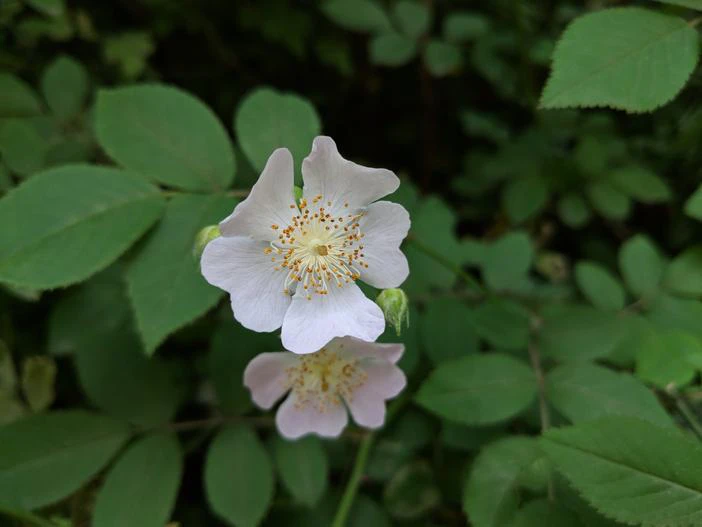Multiflora Rose
(Rosa multiflora var. cathayensis)
Multiflora Rose (Rosa multiflora var. cathayensis)
/
/

Sun Jiao (Interaccoonale)
CC BY 4.0
Image By:
Sun Jiao (Interaccoonale)
Recorded By:
Copyright:
CC BY 4.0
Copyright Notice:
Photo by: Sun Jiao (Interaccoonale) | License Type: CC BY 4.0 | License URL: https://creativecommons.org/licenses/by/4.0 | Uploader: Interaccoonale | Publisher: Wikipedia Commons








Estimated Native Range
Climate Requirements for Harlingen, Texas
| This Plant | Your Site | Plant Suitability for Your Location | ||
|---|---|---|---|---|
| • Precipitation | 54" - 72" | 28" | Your precipitation may be insufficient for this plant. Irrigate N" / year. | Irrigate N" / year |
| • High Temp. | 80°F - 93°F | 94°F | Your summer temperatures are normal for this plant. | Excellent |
| • Low Temp. | 24°F - 41°F | 49°F | Your winter temperatures are normal for this plant | Excellent |
This plant should grow well at your location with about N inches per year (Y minutes per month) of irrigation.
Summary
Rosa multiflora var. cathayensis, commonly known as Multiflora Rose, Baby Rose, or Japanese Rose, is a deciduous shrub native to East Asia, particularly found in forest edges, meadows, stream banks, and disturbed areas. It is a vigorous grower, reaching heights of 5-15 feet (1.5-4.6 meters) and widths of 5-10 feet (1.5-3 meters). This variety is characterized by its arching stems and dense growth, which can form impenetrable thickets in the wild. It produces clusters of fragrant, small flowers that are typically white or pink, blooming profusely in late spring to early summer. The flowers are highly showy, attracting pollinators such as bees and butterflies.
The Multiflora Rose is valued for its ornamental qualities, including its abundant and attractive flowers, and is often used for hedging, erosion control, and as a wildlife habitat, providing food and shelter for birds and other animals. It is adaptable to a variety of soil types, including clay, loam, and sandy soils, but requires good drainage. While it thrives in full sun, it can also tolerate part shade. Regular pruning is necessary to maintain its shape and to prevent it from becoming too invasive. Despite its beauty, Rosa multiflora var. cathayensis is considered invasive in many parts of the world, including North America, where it can outcompete native vegetation and disrupt local ecosystems. It is important to consult local regulations before planting and to manage its spread responsibly.CC BY-SA 4.0
The Multiflora Rose is valued for its ornamental qualities, including its abundant and attractive flowers, and is often used for hedging, erosion control, and as a wildlife habitat, providing food and shelter for birds and other animals. It is adaptable to a variety of soil types, including clay, loam, and sandy soils, but requires good drainage. While it thrives in full sun, it can also tolerate part shade. Regular pruning is necessary to maintain its shape and to prevent it from becoming too invasive. Despite its beauty, Rosa multiflora var. cathayensis is considered invasive in many parts of the world, including North America, where it can outcompete native vegetation and disrupt local ecosystems. It is important to consult local regulations before planting and to manage its spread responsibly.CC BY-SA 4.0
Plant Description
- Plant Type: Shrub
- Height: 5-15 feet
- Width: 5-10 feet
- Growth Rate: Rapid
- Flower Color: White, Pink
- Flowering Season: Spring, Summer
- Leaf Retention: Deciduous
Growth Requirements
- Sun: Full Sun, Part Shade
- Water: Medium
- Drainage: Medium
Common Uses
Bee Garden, Bird Garden, Butterfly Garden, Showy Flowers
Natural Habitat
Native to forest edges, meadows, stream banks, and disturbed areas in East Asia
Other Names
Common Names: Multiflora Rose, Baby Rose, Japanese Rose
Scientific Names: Rosa multiflora var. cathayensis, Rosa adenoclada, Rosa calva var. cathayensis, Rosa cathayensis, Rosa cathayensis var. exigua, Rosa gentiliana, Rosa gentiliana var. adenoclada, Rosa kwangsiensis, Rosa macrophylla var. hypoleuca
GBIF Accepted Name: Rosa multiflora var. cathayensis